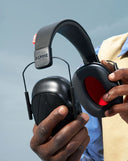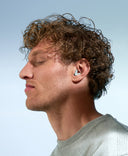The tapping of fingers on a keyboard. Someone chewing gum. A dripping tap. For most people, these are nothing more than background noise, which they probably don't even register. But if you have misophonia, such everyday sounds can be unbearable. What is misophonia and what are its symptoms? What sounds are common triggers and why do they elicit such intense responses? And what can you do if you have misophonia?
What is misophonia?
Misophonia is a disorder in which certain sounds trigger intense emotional, physical or behavioural responses, which are often considered unreasonable or excessive by others. The word 'misophonia' is derived from the Greek misos ('hate') and phónè ('sound'). The literal meaning of misophonia is therefore 'hatred of sound'. It is also referred to as noise anxiety, although selective noise sensitivity syndrome would be a more accurate description. This is because it involves reduced noise tolerance, but only to specific sounds.
The disorder can be compared to turning on a radio without knowing that the volume is at maximum. You react impulsively or instinctively to the sudden loud noise and turn down the volume as quickly as possible. With misophonia, 'trigger sounds' can impulsively or instinctively put you into fight-or-flight mode, resulting in emotional, physical or behavioural responses.
Symptoms of misophonia
Symptoms of misophonia are usually noticeable to others only when an individual is triggered. This can result in emotional, physical and/or behavioural reactions, which can range from mild to severe.
Emotional reactions
Emotional reactions are the feelings you experience when triggers occur. These can be intense and overwhelming.
Examples of emotional responses include:
-
Uneasiness
-
Annoyance
-
Anxiety
-
Disgust
-
Anger
-
Panic
An emotional response can escalate. Mild annoyance, for example, can quickly turn into anger.
Physical reactions
Physical reactions are bodily processes that occur automatically. Most are similar to what happens in your body in dangerous situations (fight/flight/freeze response).
Examples of physical responses include:
-
A faster heart rate
-
Increased blood pressure
-
Sweating
-
Pressure on the chest
-
Goosebumps
-
Muscle tension
Behavioural reactions
Behavioural reactions are usually impulsive or instinctive, which means that you don't always have control over them.
Examples of behavioural responses include:
-
Avoiding situations with potential triggers
-
Leaving the room when triggered
-
Taking action to stop the sound (for example, removing the battery from a ticking clock)
-
Verbal responses
-
Violent responses (rare)
Triggers and examples of aversion to sounds
The sounds that constitute triggers for someone with misophonia can vary from person to person. Generally, they are neutral, everyday sounds, often at low volume. Most people with misophonia have an aversion to sounds produced by others. Common triggers are oral sounds, such as:
-
Biting (into an apple, for example)
-
Chewing/chomping
-
Swallowing/slurping
-
Breathing
-
Yawning
-
Coughing/clearing the throat
-
Sneezing
-
Clearing the nose
-
Snoring
-
Kissing
Other examples of sounds that can be triggering:
-
Typing on a keyboard
-
Clicking a pen
-
Walking noises (especially with heels)
-
Scratching
-
Nail biting
-
Repetitive movements
-
The ticking of a clock
-
Dripping
-
Cutlery sounds
-
Rustling
-
Birdsong
-
Windshield wipers
In many cases, people with misophonia also respond to visual triggers when they see movement (such as the tapping of fingers on a table). If the response is triggered only by seeing specific repetitive movements, it is called misokinesia ('hatred of movements').
Causes and origins of misophonia
Symptoms of misophonia can present at any age, but usually begin between the ages of 9 and 13. Misophonia seems to be more common in girls. Because there is nothing wrong with the hearing itself, people with misophonia are often not correctly diagnosed until a later stage. Sometimes the symptoms of misophonia are mistaken for an anxiety disorder or obsessive-compulsive disorder. But what causes misophonia? That is still being researched. In any case, we already know that the cause is not related to your ears. Presumably, misophonia is caused by a combination of factors:
-
Brain structure
The cause of misophonia is thought to be primarily related to how the brain filters and processes sensory stimuli. This may involve problems with filtering and processing only auditory stimuli or only visual stimuli, or both. Recent studies point to a disruption in the connectivity of the parts of the brain responsible for both processing and interpreting sound stimuli and the fight/flight/freeze response. Since the disorder seems to be more common in neurodivergent individuals (for example, those with ADHD or autism), it is plausible that the cause is largely due to certain brains working just a little differently than in neurotypical people.
-
Intelligence and creativity
As early as the 19th century, the philosopher Arthur Schopenhauer (1788-1860) published an essay in which he linked intolerance of sounds with above-average intelligence and creativity. Schopenhauer argued that genius "is nothing more than the ability of the mind to concentrate on one thing". The connection is also supported by several recent studies. For example, researchers at Northwestern University believe that creativity may be associated with a reduced ability to filter 'irrelevant' sensory information.
-
Conditioning in childhood
Many people with misophonia associate their first symptoms with childhood, when they felt a deep aversion to hearing the eating noises of family members. This conforms with the theory that repeated conditioning from the immediate environment can result in misophonia. As yet, there is insufficient scientific evidence to properly support this theory.
Effects of misophonia
Misophonia can turn everyday activities into enormous challenges.
Maintaining your attention during an interesting lecture is a lot harder when you are triggered by the sound of a classmate's clicking pen.
A nice dinner party can feel like a real nightmare when you find out that one of your fellow diners tends to chomp or chew with their mouth open - while you struggle with anxiety over eating noises.
And it can be a turn-off if your partner turns out to snore, if snoring is a trigger for you. These are just a few examples of how the disorder can affect your life.
People with misophonia often develop anticipatory anxiety when they know they are going to be in a situation in which trigger sounds may be present. The thought of a possible response to a trigger can result in avoidant behaviour and social isolation. Lack of understanding by others can also result in conflict. The disorder can therefore seriously interfere with family, professional and social relationships.
What can you do if you have misophonia?
Although misophonia can have a big impact on your daily life, you can learn to cope with it. Here are some tips on what to do when suffering from misophonia:
-
Wear hearing protection
Purchase good earplugs or earmuffs and make sure you always have them with you so you can protect yourself from trigger noises. Alpine hearing protection for concentration not only helps to maintain focus, but also provides relief from misophonia. Do you suffer from triggers especially in the evening or at night, such as from a snoring partner? Take a look at our earplugs for sleep.
-
Limit stress
Symptoms of misophonia are often more intense at times when you experience more stress. While stress cannot always be prevented, there is much you can do to make sure you handle stress better. Your lifestyle plays a crucial role in this, so make sure you exercise regularly, eat healthily and get enough sleep. In addition, you may benefit from learning breathing exercises and simple relaxation techniques, such as progressive muscle relaxation.
-
Seek professional help
It is definitely advisable to call in a specialist, as misophonia is often treatable. Most successes are achieved by taking a multidisciplinary approach. Sound therapy can be combined with coaching or therapy, for example. Cognitive behavioural therapy (CBT) is usually very effective. In this process, you not only learn to better understand your reactions to trigger sounds, but you also develop coping strategies to control your reactions. Dialectical behaviour therapy (DBT) focuses on dealing with emotions through techniques such as mindfulness, emotional regulation and development of stress tolerance. In some cases, Tinnitus Retraining Therapy (TRT) has also been found to work well for misophonia; this involves learning to tolerate trigger sounds so they don't affect you as much. People who are frequently or quickly triggered can try a white noise device; this produces sounds designed to distract from triggers and reduce reactions.
-
Share your experiences with other misophonia patients
If you suffer greatly from your symptoms, you can quickly feel lonely, especially if you do not know anyone else with misophonia. But the disorder is more common than you think! According to a study from 2023, the percentage of people with misophonia in the United Kingdom is 18.4%. That's almost 1 in 5 people. Of course, not everyone suffers equally, but there are numerous online communities where people with misophonia share their experiences and support each other.
-
Talk about it with those closest to you
It is also important to talk about your misophonia with people close to you. Tell those you care about and trust about your triggers and what you experience. In this way, potential conflicts can be avoided. A little understanding from those around you can make a huge difference!
This article is for informational purposes only and does not replace medical advice. Have questions about your health? Contact a doctor or healthcare professional.




